
|
CHINA> Official Publication
 |
|
Full text of white paper on ethnic policy
(china.org.cn)
Updated: 2009-09-27 17:05 V. Accelerating the Economic and Social Development of the Ethnic Minorities and Minority Areas Adhering to common prosperity and development of all ethnic groups is the fundamental stance of China's ethnic policy. The Constitution stipulates, "The state does its utmost to promote the common prosperity of all ethnic groups in the country." The Law on Regional Ethnic Autonomy stipulates that it is a legal obligation of the higher-level state organs to help the minority areas accelerate their development. Over the years, the state has made it a major part of national development to promote the economic and social progress of the ethnic minorities and minority areas, and has worked out from time to time policies and measures to this end. Before the founding of New China in 1949, most minority areas had an extremely low level of productivity, backward economic and social development, and extremely poor infrastructure. There was not an inch of railway in Xinjiang, not a single highway in Tibet, and in mountainous Yunnan, horses, elephants and suspension cables were all the locals could rely on for traveling or carrying goods. People of the ethnic minorities engaged mainly in traditional agriculture and animal husbandry. Some places were still in the primitive "slash-and-burn" state. In some areas, people still used wooden and stone tools; and iron tools were not yet widespread. The ethnic minorities led a life full of misery. Life was even worse for those living in the mountainous and desert areas, where a dearth of food and clothing was common. For months almost every year they would run out of grain and had to survive on wild fruits, and in the harsh winter they had nothing to keep out the cold but straw capes. All this hindered the progress of the ethnic minorities. Some of them were on the verge of extinction, with the Hezhen numbering only some 300 people at the time of the founding of New China. It was on such an extremely backward basis that the social and economic construction of the ethnic minorities and minority areas began in New China. The CPC and the central government have always supported the development of the ethnic minorities and minority areas. When New China was established, the Chinese government made it a basic task to rid all ethnic groups of poverty and enable them to lead a better life. Since the adoption of the reform and opening-up policies in the late 1970s, the state has focused on economic construction, given top priority to development, made increasing efforts and carried out several significant measures to quicken the advance of the ethnic minorities and minority areas. Over the years, the ethnic minorities and minority areas have all along upheld the spirit of self-reliance and hard working, coupled with assistance from economically advanced parts of China and state preferential policies, striven to build better homes for themselves. Thanks to the concerted efforts of the entire nation, the ethnic minorities and minority areas have seen one leap forward after another in their economic and social progress, completely got rid of stark poverty and backwardness, and entered a stage unparalleled in history. Priority given to construction projects to consolidate the foundation for further development In the early days of New China, the state gave top priority to infrastructure construction in the minority areas. In 1952 the central government issued the Principles of the Five-year Construction Plan for the Minority Areas, involving the construction of rails and trunk roads, the repair of existing roads and bridges, and the building of postal, telegraph, telephone and other communication systems in some minority areas. During China's First Five-year Plan period (1953-1957), the state started the construction of eight trunk railways, five of which, including the Lanzhou-Urumqi and Baotou-Lanzhou lines, were in minority areas or linked them with other places. In 1954 the two world-renowned highways connecting Tibet with Sichuan and Qinghai were completed. In the 1960s more railways were built, including the Chengdu-Kunming, Changsha-Guiyang and Panzhihua-Liuzhou lines, and the Yunnan-Tibet highway was also completed. In 1962 the Lan-zhou-Urumqi railway line, the first railway line in the Xinjiang Uyghur Autonomous Region, reached Urumqi. Since the late 1970s a large number of key projects have been completed in the minority areas, including the Nanning-Kunming, Neijiang-Kunming and Southern Xin-jiang railway lines, Lhasa Airport, the Lanzhou-Xining-Lhasa optical cable, and the project for utilizing water from the Yellow River for irrigation in Ningxia, which have greatly improved the transport and communication conditions and the livelihood in those minority areas. The state has made the development of local advantageous resources and modern industry a major measure to promote the advance of the ethnic minorities and minority areas. During the First Five-year Plan period, 40 of the 156 large state construction projects were initiated in the minority areas, such as the Baotou iron and steel base in Inner Mongolia, the Karamay oilfield in Xinjiang and the Gejiu tin company in Yunnan. In the 1960s the state moved a host of large industrial enterprises from coastal areas and inland places to the minority areas, thus laying the foundation for modern industry in the latter. Since the introduction of the reform and opening-up policies, the state again has approved a large number of massive projects in the minority areas, such as the Tarim oilfield in Xinjiang, the aluminum plant in Pingguo, Guangxi, the potash fertilizer plant in Qinghai and the coal and electric power base in Inner Mongolia, leading to the formation of several important industrial bases for resources development and processing in these minority areas, and blazing a trail for industrialization based on local resources and with local characteristics. Chart 3 Growth of Industrial Output Value in the Minority Areas
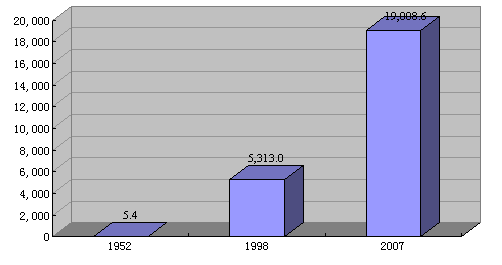 Since 2000, when China introduced the strategy of large-scale development of its western regions, the state has made it a top task to accelerate the development of the ethnic minorities and minority areas. To ensure that they get tangible benefits, the state has adopted many preferential measures, such as giving priority to these areas when arranging resources development and processing projects, giving compensation to minority places that export natural resources, guiding and encouraging enterprises from economically advanced areas to invest in these places, and increasing financial input and support to them, so as to enhance their economic strength. At present, all of China's five autonomous regions, 30 autonomous prefectures and 120 autonomous counties nationwide are either covered by the "Develop the West" campaign, or enjoy the same preferential policies as the western regions. Chart 4 Agriculture and Animal Husbandry in the Minority Areas
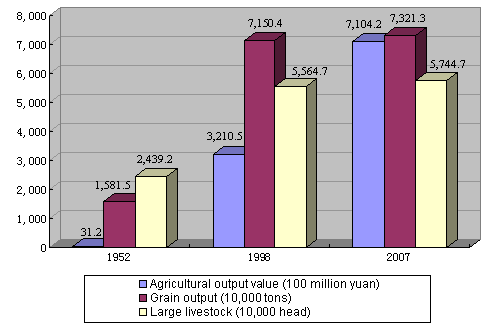 The "Develop the West" campaign has brought about visible profits to the minority areas. By 2008 the accumulated fixed assets investment in these areas amounted to 7,789.9 billion yuan. Of that, 1,845.3 billion yuan was invested in 2008, which was five times that in 2000 and a rise of 23.7 percent on an annual basis. Key projects for transmitting gas and power from the west to the east have been completed, and a number of infrastructure projects, such as airports, expressways and water conservancy hubs, have been built. In 2007 the Qinghai-Tibet Railway was extended to Lhasa, giving a rail connection to Tibet for the first time in its history. A rapid, economical, all-weather transport channel of massive capacity between Tibet and the outside world, the railway has fundamentally changed the backward transport situation in the region, and added wings to the impending economic take-off of Tibet. Chart 5 Fixed Assets Investment in the Minority Areas Since 1999
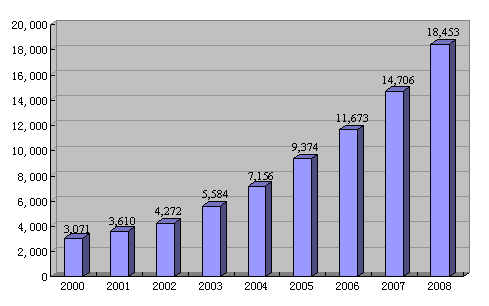 The central government requires that when planning infrastructure projects located in the minority areas the local government either be exempted from contributing capital or contribute less; when developing resources or building enterprises in these areas, due consideration be given to local interests and the production and life of the ethnic minorities; and appropriate compensation be granted to places exporting natural resources or doing their bit for the eco-balance and environmental conservation. In 1994 the state adjusted the ratio between the amount of capital from the central budget and that from autonomous region governments to 6:4, while the ratio between the central government and the government of other provinces was fixed at 5:5. In 2004 the state adopted the compensation mechanism for ecological construction and environment protection. When tapping the rich oil and gas resources in Xinjiang, attention is paid to the stimulation effect on local development. The West-East Gas Transmission project alone can bring in over one billion yuan of revenue to Xinjiang a year. Poverty being the key issue to tackle to ensure and improve the well-being of the people Over the years, the state has adopted a series of policies and measures to relieve the poverty the ethnic minorities suffer. In the 1950s, the state provided free medical services to poor people of the ethnic minorities, granted them loans and farming tools, helped them set up schools and conducted social relief. In 1983, the State Council held a national meeting on production and livelihood in the minority areas, which decided to basically solve the problems of food and clothing, housing and drinking water within a short time. Since 1990 the state has set up a fund to assure the basic needs of people living in poverty-stricken minority areas, and 141 impoverished counties were listed as the first batch to gain this support. In 1994 the Seven-year Poverty Alleviation Program (a program designated to lift 80 million people out of absolute poverty in the seven years 1994-2000) was carried out, and, with the assistance threshold lowered, 116 more poverty-stricken minority counties were covered by state preferential policies. In 2001 the Outline of Rural Poverty-relief Development was implemented, with ten more minority counties included, and Tibet as special region covered. In 2005 the comprehensive development of poor minority villages became the focus of national poverty-relief efforts. In 2007 the state formulated the 11th Five-year Plan for the Development of the Ethnic Minorities, containing 11 key projects. In 2009 the state announced new standards for poverty-relief work, and expanded the coverage to low-income rural people in the minority areas. Other efforts include: providing work as a form of relief, relocating people from places with poor conditions, building settlements for formerly nomadic people, repairing dangerous housing for rural residents, supplying safe drinking water in rural areas, and providing minimum living allowances to rural and urban residents. Thanks to continuous efforts in these endeavors, the impoverished population in the minority areas shrank from some 40 million in 1985 to 7.7 million in 2008. Because of differences in history, culture, customs and religion, some ethnic minorities have special needs. For instance, the Tibetan, Mongolian, Uyghur and Kazak herdsmen need saddles, riding boots and brick tea, and the Muslims have their own special needs for Halal foods. To show respect for minority cultures and satisfy these special needs, the state has worked out preferential policies for the production of and trade in these items. In 1963 the state introduced preferential policies for ethnic-minority enterprises regarding profit retention, self-owned funds and price subsidies. In 1997 it enacted new preferential policies, set up special loans with discounted interest and exempted some enterprises from paying added value tax, benefiting 1,760 designated producers of special commodities needed by the ethnic minorities. In 1991 a mechanism for national brick-tea reserves was established to guarantee the supply of brick tea. In 2007 the state established a fund to ensure the production and promotion of the special commodities needed by the ethnic minorities, as well as related personnel training. Priority is also given by the state to improving medical and health care for the ethnic minorities and in the minority areas. The level of medical services in minority urban areas has been remarkably enhanced, the medical conditions in agricultural and pastoral areas have been noticeably improved, the difficulty of the ethnic minorities in getting adequate medical service has been alleviated, and the health of the ethnic minorities been improved considerably. Since the introduction of the reform and opening-up policies, the state has built or renovated township hospitals, and county-level epidemic-prevention stations and health centers for women and children, thus greatly improving the health-care services in the minority areas. More than 80 percent of the counties in Tibet now have epidemic-prevention stations. The state is making continuous efforts to prevent and treat endemic and epidemic diseases in the minority areas, and the once-prevalent Keshan disease, tuberculosis and Kaschin-Beck disease have been basically put under control. Through various channels, the state has trained health care workers for the ethnic minorities, and expanded the contingent of medical professionals. In Xinjiang one third of all medical workers are from ethnic minorities. Chart 6 Improvement of Medical Services in the Minority Areas
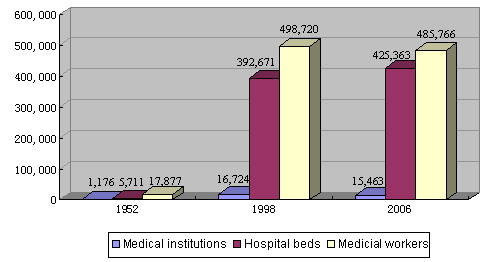 Vigorous support for the pasturelands and borderlands for balanced development China's major pasturelands are all located in areas inhabited by the ethnic minorities, and animal husbandry has been the basic industry for most or part of the Mongolians, Tibetans, Kazaks and a dozen other ethnic minorities since ancient times. Since 1953 a milder taxation policy than in cities and farming areas has been enforced in the pasturelands, in addition to policies encouraging pasture protection and the settlement of nomadic people. After China began its reform and opening-up, the state adopted policies that allowed households to own livestock and contract pastures for independent operation. At a national work conference for pastoral areas held in 1987 the State Council listed 27 poverty-stricken pastureland counties as eligible for state assistance, and granted poverty-relief loans with discounted interest to support the pasturelands. To ensure the balanced development of animal husbandry and agriculture, in 1999 the Chinese government stressed that equal emphasis should be placed on grassland construction and farmland capital construction. In 2005 the state abolished taxes on agriculture and animal husbandry. After decades of unremitting endeavors, the minority areas have grown into important production bases of agricultural and animal products. Inner Mongolia now produces one fifth of the nation's total milk, ranking first in China in milk production, and Xinjiang is the country's second-biggest producer of wool and cashmere. Most of China's borderlands are inhabited by ethnic minorities. In 1979 the state worked out the Borderlands Construction Plan (Draft), allocating 40 billion yuan for the construction of these areas over eight years. In 1992 China implemented its frontier opening-up strategy, designating 13 open cities and 241 first-grade open ports, and establishing 14 border economic and technological cooperation zones. In 1996 the State Council worked out preferential policies for promoting border trade and economic cooperation with other countries. In 1999 the state initiated a program to boost the borderlands' economy and help the local residents raise their incomes. This was followed by the formulation and execution of the 11th Five-year Plan for the Economic Development of the Borderlands, starting in 2005. In 2009 the government decided to expand the program to all frontier counties and the frontier farms under the Xinjiang Production and Construction Corps. So far, the central government has invested 1.446 billion yuan and built more than 20,000 projects in the borderlands. For decades the state has paid steady attention to the construction and protection of ecological environment in the minority areas. Especially since the launch of the "Develop the West" campaign, a series of policies and measures have been executed, including prohibiting tree felling on the upper reaches of major rivers, returning farmlands to forests and grasslands and closing hillsides for afforestation. As compensation, the state has distributed grain to farmers and herdsmen to make up for their losses in returning their farmlands to forests or grasslands, and subsidies to places where revenue has shrunk because of the restriction on tree felling. In recent years, the Chinese government has increased its support for the sparsely-populated minority areas with poor conditions. In 2005 it formulated and implemented the Program to Support the Ethnic Minorities with Small Populations (2005-2010), and listed 640 ethnic-minority villages as recipients of assistance. So far, 1.253 billion yuan has been forthcoming for these areas from the central government. Constantly increasing financial support and actively organizing paired-up assistance Over the past 60 years both the central and local governments at all levels have gradually increased their efforts to extend fiscal transfer payments to the minority areas. In the 1950s the state began to implement preferential fiscal policies for these areas, such as "unified collection of revenues and allocation of expenditures and subsidies for the needy," and raising the proportion of the financial reserve fund (two percentage points higher than in other regions). From 1980 to 1988 the central financial authorities adopted a quota subsidy system with a yearly increase of ten percent for the five autonomous regions and the three provinces with large ethnic-minority populations — Guizhou, Yunnan and Qinghai. In 1994 the state began to adopt a tax-sharing system, and introduced the system of policy-related transfer payments to the minority areas. In 2000 China initiated transfer payments for the minority areas on top of the general transfer payments and special-fund transfer payments as prescribed by relevant regulations. From 1978 to 2008 the total transfer payments by the central financial authorities to the minority areas totaled 2,088.94 billion yuan, with an annual increase of 15.6 percent. In 2008 alone the amount was 425.3 billion yuan, making up 23.8 percent of the nation's total transfer payments. According to incomplete statistics, from 1959, when democratic reform began in Tibet, to 2008, fiscal assistance from the central budget to Tibet reached 201.9 billion yuan, with an annual increase of nearly 12 percent; from 1955, when the Xinjiang Uyghur Autonomous Region was established, to 2008, the fiscal assistance from the central budget to Xinjiang reached 375.202 billion yuan, with an annual increase of 11 percent, the sum in 2008 being 68.56 billion yuan. In addition, the state has also set up a variety of special funds to help resolve the difficulties encountered by the minority areas and accelerate their development, including education development subsidies for the ethnic minorities set up in 1951, minority area subsidies set up in 1955, the minority-area reserve fund set up in 1964, subsidy for border construction set up in 1977, fund for aiding economically underdeveloped areas set up in 1980, and fund for the development of the ethnic minorities set up in 1992. The state vigorously organizes and encourages paired-up assistance between the economically developed areas and the less-developed minority areas. In 1979 it decided to pair up such areas, for example, getting Beijing to assist Inner Mongolia, Hebei to assist Guizhou, Jiangsu to assist Guangxi and Xinjiang, Shandong to assist Qinghai, Shanghai to assist Yunnan and Ningxia, and the whole nation to assist Tibet. In 1996 the State Council determined to organize the 15 developed provinces and cities along the eastern coast to provide aid to 11 western provinces (autonomous regions and municipality directly under the central government), and mobilized all departments of the central government to provide pair-up aid to the impoverished areas. In order to promote the development of Tibet, the central government has held four forums on work in that region. Since 1994 the state has arranged more than 60 central government departments, 18 provinces (municipalities directly under the central government) and 17 state-owned enterprises to provide paired-up aid to various places in Tibet. By the end of 2008, a total of 6,050 assistance projects had been launched in Tibet, with a total of 11.128 billion yuan in assistance money. In recent years the state has further strengthened its efforts to aid the ethnic minorities and minority areas under the guidance of the Scientific Outlook on Development. In 2005 the CPC Central Committee and the State Council jointly issued the Decision on Further Strengthening the Work on the Ethnic Minorities and Promoting Social and Economic Development in the Minority Areas, which stipulated that development is the key to overcoming difficulties and solving problems in the minority areas, and stressed that, with the gradual increase of the country's comprehensive strength, the central government would continuously strengthen support to the ethnic minorities and minority areas in their social and economic development, improve the policy-related transfer payment system compatible with the system of regional ethnic autonomy, help the minority areas build infrastructure projects that will give an impetus to local social and economic development and give special treatment to small and medium-sized public welfare projects that are closely related to the everyday life of local people. In 2007 the State Council released Some Opinions on Further Promoting Social and Economic Development in the Xinjiang Uyghur Autonomous Region, which contained requirements and plans to accelerate the social and economic development of Xinjiang and further improve the living standards of the people of all ethnic groups there. Since 2008 the state has drawn up and issued a series of preferential policies to promote the social and economic development of the Tibetan-inhabited areas in Ningxia and Qinghai and the border areas of Yunnan, increasing input to strengthen the building of infrastructure, develop competitive industry, push forward the development of social undertakings and accelerate the social and economic development of the minority areas there. Under the central leadership and with the full support of the whole nation and the strenuous efforts made by the people of all ethnic groups in the minority areas, great achievements in social and economic development have been scored in the minority areas, and people's living standards there have markedly improved. In 2008 the economic aggregate of the minority areas reached 3,062.62 billion yuan, from 5.79 billion yuan in 1952, an increase of 92.5 times calculated at comparable prices. The urban per-capita disposable income increased to 13,170 yuan from 307 yuan in 1978, an increase of over 30 times; and the per-capita net income of farmers and herdsmen came to 3,389 yuan from 138 yuan in 1978, an increase of 19 times. The economic growth rate of Inner Mongolia has ranked top in the country for seven consecutive years, and Xinjiang has maintained double-digit growth for six years in succession. In the same year, the GDP of Tibet stood at 39.591 billion yuan, an increase of 65 times compared with 1959. The rapid economic and social development in the minority areas has laid a solid foundation for the prosperity of all ethnic groups. According to the national census of 2000, the average life expectancy of 13 ethnic minorities was above the average national level of 71.40 years, and seven above the average Han level of 73.34 years. The population of the Hezhe ethnic group has increased from 300 in the early days of New China to over 4,000. Xinjiang is listed by the International Medical Union as one of the four regions in the world renowned for longevity, with the biggest number of people over 100 years among every million people in the country. The average life expectancy of Tibet has increased from 35.5 years in 1951, when it was peacefully liberated, to 67 years now, with 13,581 seniors aged from 80 to 99, and 62 seniors aged over 100; it is now among the regions with the most centenarians on average in China. Chart 7 A Comparison of GDP Growth Rates of Eight Ethnic Minority Regions (Provinces) with National GDP Growth Rates
*Note: The eight autonomous regions and provinces where ethnic minorities live in compact communities are: Inner Mongolia, Xinjiang, Guangxi, Ningxia and Tibet autonomous regions, and Guizhou, Yunnan and Qinghai provinces. Chart 8 GDP and Fiscal Revenue of the Minority Areas
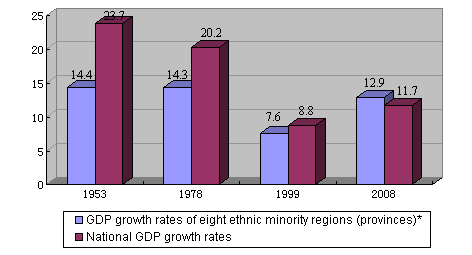 |